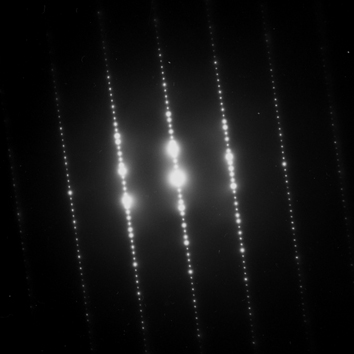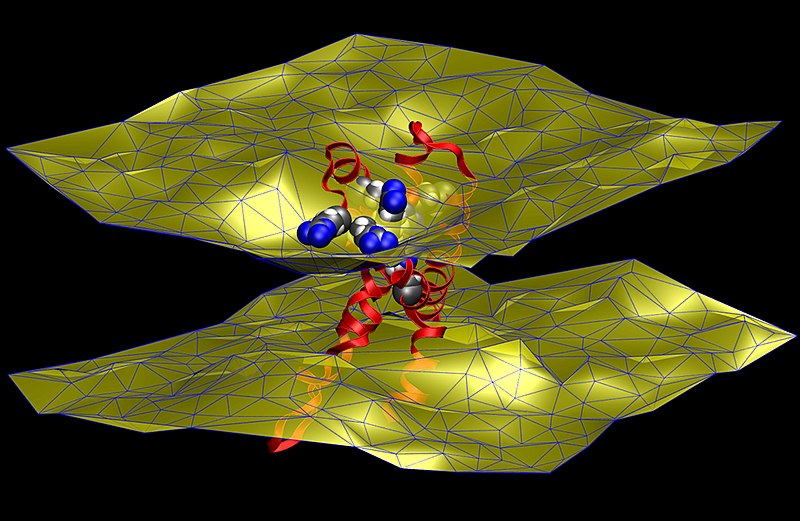The key difference between electron and neutron diffraction is that electrons are scattered by atomic electrons, whereas neutrons are scattered by atomic nuclei.
Electron diffraction is the wave nature of electrons. Neutron diffraction is the phenomenon of elastic neutron scattering. Typically, electron diffraction describes the wave-like nature, while neutron diffraction describes the atomic and/or magnetic structure of a material.
CONTENTS
1. Overview and Key Difference
2. What is Electron Diffraction
3. What is Neutron Diffraction
4. Electron vs Neutron Diffraction in Tabular Form
5. Summary – Electron vs Neutron Diffraction
What is Electron Diffraction?
Electron diffraction is the wave nature of electrons. Practically, it is the technique that is used to study matter through firing electrons at a sample and observing the resulting interference pattern. We commonly call this phenomenon the wave-particle duality. It states that a certain particle of matter behaves as a wave. Therefore, an electron can be considered as a wave similar to sound or water waves. The electron diffraction technique is similar to X-ray diffraction and neutron diffraction techniques.
Most frequently, electron diffraction is useful in solid state physics and chemistry for the understanding of the crystal structure of solids. Usually, we can perform this type of experiment in a transmission electron microscope (TEM) or a scanning electron microscope (SEM). These instruments use electrons that are accelerated by an electrostatic potential to obtain the desired energy and to determine the wavelength prior to the interaction with the sample of desire.

Figure 01: A Typical Electron Diffraction Pattern
Although this technique is mainly useful in the study of periodically perfect crystals such as electron crystallography, it is also useful in the study of short-range order of amorphous solids, the short-range ordering of imperfections including vacancies, the geometry of the gaseous molecules, etc.
What is Neutron Diffraction?
Neutron diffraction is the phenomenon of elastic neutron scattering. It is the application of neutron scattering to determine the atomic and/or magnetic structure of a material. We need to place the sample to be examined in a beam of thermal or cold neutrons. Then we can obtain a diffraction pattern that can provide information on the structure of the material.

Figure 02: Neutron Diffraction that is Useful in Molecular Stimulations
The neutron diffraction method is similar to X-ray diffraction. However, due to different scattering properties, neutrons and X-rays tend to provide complementary information; for example, X-rays are suited for superficial analysis, strong X-rays from synchrotron radiation are suitable for shallow depths or thin specimens, etc.
Typically, the neutron diffraction technique requires a source of neutrons produced in a nuclear reactor or spallation source. If we use a research reactor, we need other components such as crystal monochromator, filters to select the required neutron wavelength, etc.
Difference Between Electron and Neutron Diffraction
Electrons and neutron diffraction are important analytical techniques. The key difference between electron and neutron diffraction is that electrons are scattered by atomic electrons, whereas neutrons are scattered by atomic nuclei. Moreovver, electron diffraction is the wave nature of electrons. Neutron diffraction is the phenomenon of elastic neutron scattering. Typically, electron diffraction describes the wave-like nature, while neutron diffraction describes the atomic and/or magnetic structure of a material.
Below is a summary of the difference between electron and neutron diffraction in tabular form for side by side comparison.
Summary – Electron vs Neutron Diffraction
Electron diffraction is the wave nature of electrons. Neutron diffraction is the phenomenon of elastic neutron scattering. The key difference between electron and neutron diffraction is that electrons are scattered by atomic electrons, whereas neutrons are scattered by atomic nuclei. Typically, electron diffraction describes the wave-like nature, while neutron diffraction describes the atomic and/or magnetic structure of a material.
Reference:
1. Pang, W.K., and I.M. Low. Understanding And Improving The Thermal Stability Of Layered Ternary Carbides In Ceramic Matrix Composites. 2022.
Image Courtesy:
1. “DifraccionElectronesMET” By Oysteinp at the English-language Wikipedia (CC BY-SA 3.0) via Commons Wikimedia
2. “Neutron diffraction; Ion channels (5888008521)” By National Institute of Standards and Technology – Neutron diffraction; Ion channels (Public Domain) via Commons Wikimedia
ncG1vNJzZmivp6x7pbXFn5yrnZ6YsqOx07CcnqZemLyue9ahmK1lmah6tbTEZpuinpaav6a6wp5km52krLKmuoyeo56bpKe8r3nAp5tmppWqwbO7zWabop6Wp66kwMiopWg%3D